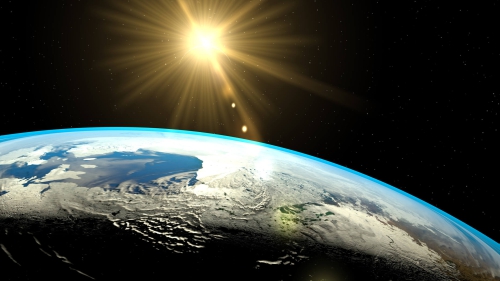As you wake up for Fajr

As you wake up for Fajr, the next three mornings you will be treated to an array of the morning planets and be able to appreciate the beauty and magnificence of God's creation.
The dawn sky will be sparkling with planets (Mercury, Venus and Saturn), bright stars and a lovely crescent Moon.
Morning Planets
NASA September 9, 2004: For the first time in almost two years, there are no bright planets in the evening sky. Not Jupiter. Not Mars. Not Venus or Saturn. You might as well stay inside and eat dinner.
The morning sky, on the other hand, is sparkling. Mercury. Venus. Saturn. A slender crescent Moon. The luminous stars of Orion. They're all on display in the days ahead: Sept. 10th through 12th.
That's the good news. The bad news is, to see them, you have to be outside before sunrise. But the view is guaranteed to wake you up.
Let's start at the bottom with Mercury. Hovering close to the eastern horizon at dawn, it looks like a bright pink star. On Sept. 12th the slender crescent Moon will hang just above Mercury, helping you find it. Mercury rarely moves far enough from the glaring sun to see. This weekend's apparition is the best of 2004.
Mercury is a world of mystery: Only one spacecraft, Mariner 10, has visited Mercury, and that was a brief encounter some 30 years ago. Mariner 10's photos, which cover less than half the planet, reveal a hot and barren world pitted with craters. It looks a lot like the Moon.
The photos also reveal strange cracks in Mercury's surface where the planet appears to be buckling from within. Is Mercury shrinking? Some scientists think so. Mercury could be contracting as its iron core slowly cools. A NASA spacecraft named MESSENGER, en route to Mercury now, will test the theory when it arrives in 2011.
There's more: Although it is scorching hot, some parts of Mercury's surface (near the poles) may be covered with ice--this according to Earth-based radars that have pinged Mercury from afar. Finding that ice, if it exists, will be a top priority for MESSENGER.
Next up is Venus, the brightest of all planets. It's the first thing you notice when you go outside, dazzling above Mercury in the eastern sky. Venus is so bright because its global clouds reflect more than 70% of the sunlight that hits them. Mercury, for comparison, reflects less than 6%. Look at the two planets, back and forth; you can see the difference.
Don't be fooled by Venus' beauty; it's a terrible place. Because of its carbon dioxide atmosphere, Venus experiences a runaway greenhouse effect. The planet's surface is hot enough to melt lead; the air pressure, 90 times that of Earth, is crushing; and the clouds are laced with sulfuric acid. The last spacecraft to land there, Russia's Venera 14 in 1982, survived only 57 minutes.
Now look just above Venus for a bright yellow star. That's Saturn.
The NASA-European Space Agency spacecraft Cassini is there now, photographing Saturn's spectacular rings, studying the planet's weather and magnetic field, and preparing to explore Saturn's mysterious moon Titan. Cassini beams images to Earth every day; you can see them at the Cassini web site.
If you have a telescope, point it at Saturn. Even a small 'scope will reveal Saturn's rings; they're breathtaking. You can see the phases of Venus, too. At the moment the planet looks like a half-moon. But don't bother looking at Mercury. It's not particularly impressive seen through a backyard telescope. Plus, even now, it's too close to the sun for comfort.
The big picture is better anyway. For the next few days, the crescent moon will be gliding among these planets--the whole scene framed by the sparkling constellations Gemini and Orion. The brightest star in the sky, Sirius, is there, too.
|
Credits |
Production Editor: Dr. Tony Phillips |
|
The Science Directorate at NASA's Marshall Space Flight Center sponsors the Science@NASA web sites. The mission of Science@NASA is to help the public understand how exciting NASA research is and to help NASA scientists fulfill their outreach responsibilities. |
|

















